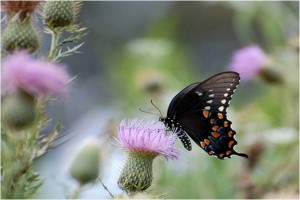Pipevine Swallowtail (Battus philenor) is a beautiful butterfly common over a large geographic area of North and Central America. Pipevine swallowtail can be sighted in open meadows, parks, along streams, and hopefully in your garden.
The butterfly larvae (caterpillars) feed on plant members of the pipevine family (Aristolochiaceae), particularly Dutchman’s pipevine (Aristolochia spp.), including Virginia snakeroot. This native vine, found in the Eastern United States, is a fast-growing perennial that can be easily trained to a fence or trellis. It may take 1-2 years for a pipevine to mature into a sizeable vine to become noticed.
Initially, young black or red caterpillars are not poisonous. They feed the poisonous leaves of pipevine and become toxic to predators, particularly birds; but the swallowtails are not harmed. The caterpillars generally eat for 10-15 days, grow, and mature. Full grown caterpillars are mostly black and covered with red spines. Other similarly colored swallowtail species try to mimic the pipevine swallowtail.
An adult butterfly develops quickly inside the green and brown chrysalis and emerges to fly, mate, and lay eggs over 7-10 days. Swallowtail wing span averages 3 to 3 ½ inches across. As autumn nears, pipevine swallowtail may remain in the chrysalis stage through the winter and emerge next spring. In areas with a long growing season, it may reproduce twice, but often the second generation overwinters in the chrysalis.
Pipevine swallowtail butterflies drink nectar from a large selection of flowers. Favorite nectar plants include milkweeds (Asclepias spp.), thistles, honeysuckles (Lonicera spp.), joe pye (Eupatorium spp.), lilac, anise hyssop (Agastache), phlox, purple coneflower, clover, beebalm (Monarda spp.), teasel, garden sage (Salvia), buttonbush, butterfly bush (Buddleia), azaleas, summersweet shrub (Clethra), and many others.


 Posted in
Posted in 
